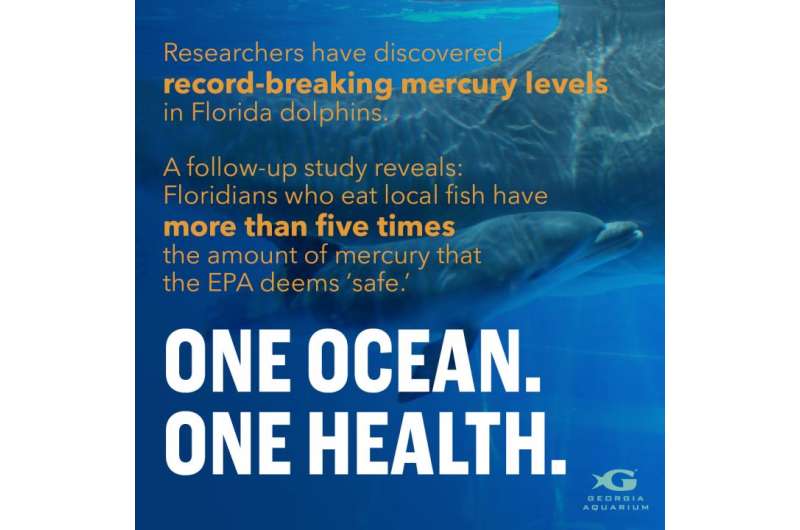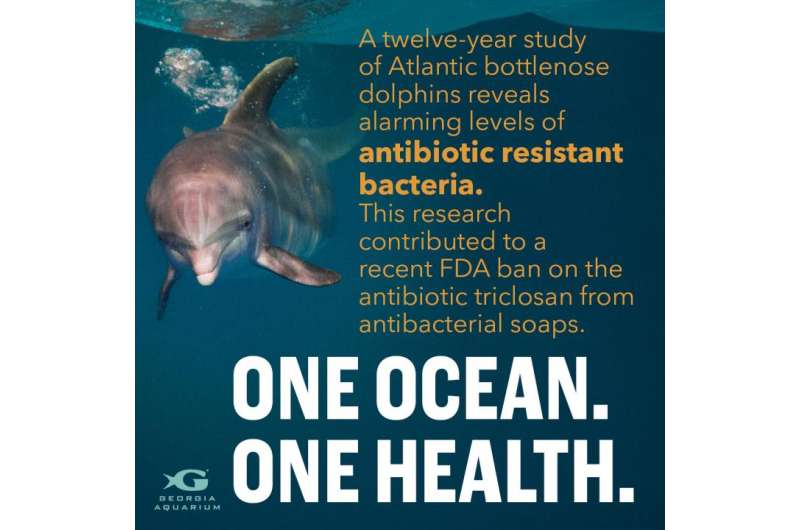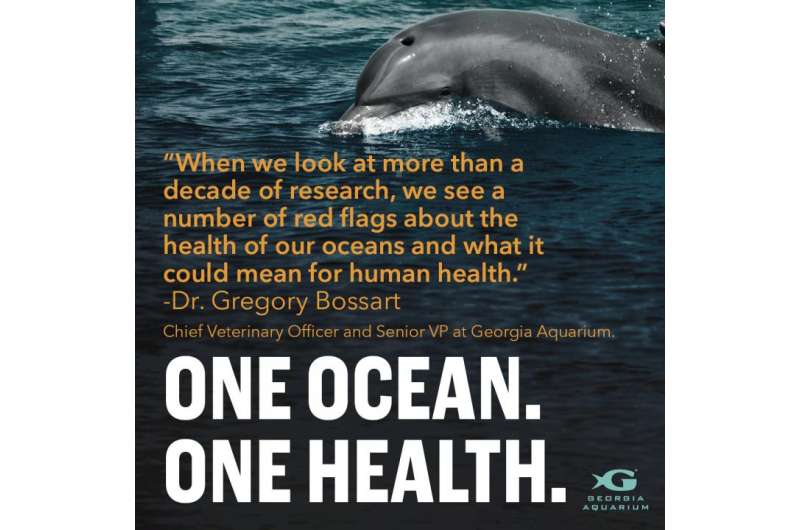Studies reveal worrisome trend for health of wild dolphins

Twelve years of data on the health of two Atlantic bottlenose dolphin populations paints a grim reality concerning the wellbeing of the Atlantic Ocean. The research, published as two companion review papers July 24 in the scientific journal Diseases in Aquatic Organisms (here and here), compiles findings from Georgia Aquarium, Harbor Branch Oceanographic Institution at Florida Atlantic University and a number of contributing partners as part of the Health and Environmental Risk Assessment Project (HERA) from 2003-2015. In addition to informing researchers about the health of dolphins, the data have prompted additional studies on how the environment may impact human health.
"When we look at more than a decade of research, analyzing long-term health data and trends and a variety of environmental factors, we see a number of red flags about the health of our oceans and what it could potentially mean for human health," said Dr. Gregory Bossart, lead author of one of the companion papers, HERA federal permit holder and Chief Veterinary Officer and Senior Vice President at Georgia Aquarium.
The papers examine biological samples and data from 360 dolphins living in two populations - one living near Charleston, S.C. (CHS) and the other in Florida's Indian River Lagoon (IRL) - and each focus on one aspect of dolphin health. The first reviews general clinical health and infectious diseases of the apex predators, while the second explores the role that environmental contamination with chemical and microbial agents play in population health. Paired together, the two papers provide a holistic look at how these two Atlantic bottlenose dolphin populations are responding to a number of natural and anthropogenic threats. The papers also summarize one of the most in-depth studies using a sentinel approach - an effort to look at a specific species to learn not just about their overall health, but also about the state of the surrounding environment and their relationship to human health.
Health and infectious disease aspects of the Atlantic bottlenose dolphin
Each year, researchers performed health assessments on one or both of the dolphin populations, collecting the animals long enough to make observations and secure biological samples to culture dolphins for microorganisms, conduct pathological examinations of lesions and test for antibodies related to several known diseases/infections. Once samples were collected, the researchers then safely released the animals back into their native environment. The data and samples collected allowed scientists to develop health classifications to keep track of disease prevalence among the dolphins. The animals were classified into three separate categories - normal, possible disease and definite disease.
Between 2003-2005, researchers saw a jump in the prevalence of disease, with the percentage of "definite disease" rising from 9 percent to 33 percent for the CHS population and from 28.6 percent to 50 percent in the IRL population. As of 2015, 32.5 percent of all IRL dolphins assessed by HERA were classified as "definite disease."
"Today, fewer than half of the dolphins we are seeing as part of our health assessments can be classified as healthy," said Dr. Bossart. "While this number has remained relatively stable since 2005, it is clear these populations are experiencing a health burden largely driven by infectious disease and environmental exposures."

Researchers tested the populations for a variety of known diseases, identifying the presence of antibodies to cetacean morbillivirus, an illness that has previously caused massive dolphin die-offs along the Atlantic seaboard. The dolphins have also tested positive for antibodies to viruses like West Nile virus, the first time it was documented in cetaceans (2009).
Finally, both fungal infections and papilloma virus were well-documented during the health assessments. Additional monitoring is required to determine if the papilloma virus lesions can undergo malignant transformation and become life-threatening cancer in free-ranging dolphins. It's possible that an altered or weakened immune system leaves the dolphins susceptible to a fungal infection widely known as lobomycosis, a disease that affects only dolphins and humans and occurs in nearly 10 percent of IRL dolphins.
Environmental Aspects of Bottlenose Dolphin Health
Researchers documented various environmental stressors and human activities that might play a role in the immuno-response of the animals. While there were few clinical differences in the health of the CHS and IRL dolphin populations, the environmental risks vary widely.
One of the most alarming findings came from the IRL dolphin population, where researchers documented mercury concentrations in the blood and skin of the animals that are among the highest recorded worldwide - five times higher than those in CHS dolphins. Mercury is a global contaminant released into the environment through a number of industrial activities. It is a known neurotoxin that can cause cognitive and developmental impairment in the fetus when exposure occurs during pregnancy. These levels of mercury also appear to suppress the immune system of the IRL dolphins and have detrimental effects on their endocrine, hepatic and hematopoietic systems.
The principal source of exposure to mercury in humans is the consumption of fish and shellfish. The high concentrations of mercury in dolphins in Florida suggested the adjacent human population of approximately 2.5 million people might be at risk. HERA research led to a study of hair samples from 135 coastal residents:
- Over half of the participants had mercury concentration which exceeded the exposure guideline established by the U.S. EPA.
- The mercury concentration in women were significantly lower than in men, however they were still five times higher than those from a nationally representative sample of U.S. women of childbearing age.
- The mercury concentrations in all participants were associated with consumption of seafood and consumption of locally caught fish.
- A study of mercury levels in pregnant women in Florida is currently underway.

"What began as health assessments to understand the wellbeing of these dolphin populations quickly became an indicator that our own environments and health might be at risk," said Dr. John Reif, lead author of one of the companion papers and Professor of Environmental and Radiological Health Sciences at Colorado State University. "HERA has proven beyond a shadow of a doubt that dolphins are an incredibly important sentinel species - informing us about their own health as well as the health of our surroundings and risks to the local human population."
By contrast, CHS dolphins were found to have high concentrations of organic chemicals in their tissues including PCBs, DDT and others. The concentrations of perfluorinated compounds (PFAA)s were among the highest levels measured globally in marine mammals. Similar to the IRL mercury findings, this has motivated a study on human residents nearby to determine whether they have higher concentrations of the chemicals as well.
Researchers documented dangerously high levels of both PCB's (industrial coolants and lubricants) and DDT (pesticides) from agricultural and industrial run-off in both dolphin populations. The detrimental toxicological implications of contaminants such as DDT and PCBs are well established in many species, but remain uncertain for marine mammals.
The first detection of triclosan, an anti-bacterial compound, in marine mammals was reported in IRL and CHS dolphins at levels similar to those reported for humans. This study added to the evidence on the persistence of these antimicrobials and contributed in part to a recent FDA rule which removed these chemicals from over-the-counter antibacterial washes.
Finally, HERA research identified a high prevalence of resistance to antibiotics in organisms cultured from IRL and CHS dolphins - one of the leading public health issues worldwide. Resistance to erythromycin, ampicillin and cephalothin all commonly used in both humans and animals was found at the highest frequency.
The discharge of many antibiotics commonly used in human and veterinary medicine directly via septic tanks and effluents or indirectly through estuarine drainage systems is likely responsible for the shared patterns of resistance found in dolphins, humans and domestic animals.
More information: GD Bossart et al. Health and Environmental Risk Assessment Project for bottlenose dolphins Tursiops truncatus from the southeastern USA. I. Infectious diseases, Diseases of Aquatic Organisms (2017). DOI: 10.3354/dao03142
JS Reif et al. Health and Environmental Risk Assessment Project for bottlenose dolphins Tursiops truncatus from the southeastern USA. II. Environmental aspects, Diseases of Aquatic Organisms (2017). DOI: 10.3354/dao03143
Provided by Georgia Aquarium



















